Solar System: Things To Know This Week
Solar System: Things to Know This Week
Our solar system is huge, let us break it down for you. Here are a few things to know this week:
1. Juno Eyes on Jupiter

After a journey of more than five years, the Juno spacecraft is ready for its detailed look at Jupiter—arrival date: July 4. Using Eyes on the Solar System and data from the Juno flight team, you can take a virtual ride onboard the spacecraft in the “Eyes on Juno” simulation.
2. Taking a Spacecraft for a Spin
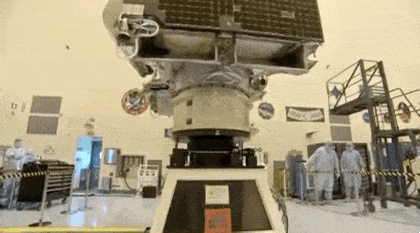
Preparations for the launch of the OSIRIS-REx asteroid mission are spinning up, literally. Here, the spacecraft can be seen rotating on a spin table during a weight and center of gravity verification test at our Kennedy Space Center. Liftoff is scheduled for Sept. 8. This spacecraft will travel to a near-Earth asteroid called Bennu and bring a small sample back to Earth for study.
3. Long-Range (Or at Least Long-Distance) Weather Report
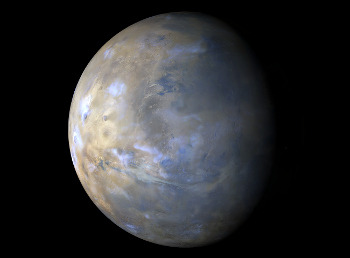
Our Mars Reconnaissance Orbiter acquires a global view of the red planet and its weather every day. Last week, dust storms continued along the south polar ice cap edge. Northern portions of Sirenum, Solis, and Noachis also experienced some local dust-lifting activity. A large dust storm propagated eastward over the plains of Arcadia at the beginning of the week, but subsided just a few days later over Acidalia.
4. Hello from the Dark Side

The New Horizons spacecraft took this stunning image of Pluto only a few minutes after closest approach in July 2015, with the sun on the other side of Pluto. Sunlight filters through Pluto’s complex atmospheric haze layers. Looking back at Pluto with images like this gives New Horizons scientists information about Pluto’s hazes and surface properties that they can’t get from images taken on approach.
5. A Titanic Encounter
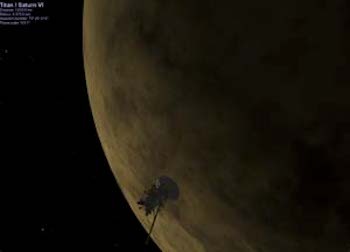
On June 7, our Cassini orbiter will fly very close by Saturn’s giant, haze-shrouded moon Titan. Among the targets of its observations will be the edge of the vortex that swirls in Titan’s thick atmosphere near its south pole.
Want to learn more? Read our full list of the 10 things to know this week about the solar system HERE.
Make sure to follow us on Tumblr for your regular dose of space: http://nasa.tumblr.com
More Posts from Carlosalberthreis and Others
Mercury In the Spotlight
For more than seven hours on Monday, May 9, Mercury will be visible as a tiny black dot crossing the face of the sun. This rare event – which happens only slightly more than once a decade – is called a transit.

Although Mercury whips around the sun every 88 days – over four times faster than Earth – the three bodies rarely align. Because Mercury orbits in a plane 7 degrees tilted from Earth’s orbit, it usually darts above or below our line of sight to the sun. As a result, a Mercury transit happens only about 13 times a century. The last one was in 2006, and the next one isn’t until 2019.

When: On May 9, shortly after 7:00 a.m. EDT, Mercury will appear as a tiny black dot against a blazing backdrop, traversing the sun’s disk over seven and a half hours. Mercury will cross the edge of the sun (ingress) after 7:00 a.m. EDT. The mid-transit point will occur a little after 10:45 a.m. EDT, with egress around 2:30 p.m. EDT.
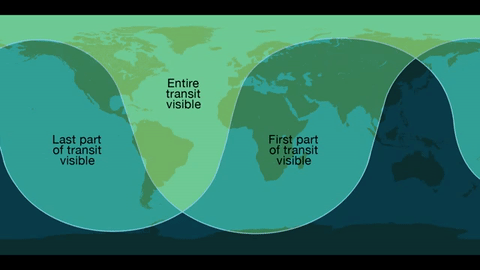
Where: Skywatchers in Western Europe, South America and eastern North America will be able to see the entirety of the transit. The entire 7.5-hour path across the sun will be visible across the Eastern U.S. – with magnification and proper solar filters – while those in the West can observe the transit in progress at sunrise.

Safety!
Unlike the 2012 Venus transit of the sun, Mercury is too small to be visible without magnification from a telescope or high-powered binoculars. Both must have safe solar filters made of specially-coated glass or Mylar; you can never look directly at the sun. We’re offering several avenues for the public to view the event without specialized and costly equipment, including images on NASA.gov, a one-hour NASA Television special, and social media coverage.

The Science…Why are Planetary Transits Important?
Transits like this allowed scientists in the 17th century to make the first estimates of Earth’s distance from the sun. Transit observations over the past few centuries have also helped scientists study everything from the atmosphere of Venus to the slight shifts in Mercury’s orbit that could only be explained by the theory of general relativity. Because we know Mercury’s size and location precisely, this transit will help scientists calibrate telescopes on solar observatories SDO, SOHO, and Hinode.

Transits can also teach us more about planets – both in and out of our solar system. The Venus transit in 2012 provided observations of the planet’s atmosphere. Transits are also the main way we find planets outside the solar system, called exoplanets.

The transit method looks for a drop in the brightness of a star when a planet passes in front of it. This method will not find every planet – only those that happen to cross our line of sight from Earth to the star. But with enough sensitivity, the transit method through continuous monitoring is a great way to detect small, Earth-size planets, and has the advantage of giving us both the planet’s size (from the fraction of starlight blocked), as well as its orbit (from the period between transits). Our Kepler/K2 mission uses this method to find exoplanets, as will the Transiting Exoplanet Survey Satellites, or TESS, following its launch in 2017/2018.
We will stream a live program on NASA TV and the agency’s Facebook page from 10:30 to 11:30 a.m. – an informal roundtable during which experts representing planetary, heliophysics and astrophysics will discuss the science behind the Mercury transit. Viewers can ask questions via Facebook and Twitter using #AskNASA.
Make sure to follow us on Tumblr for your regular dose of space: http://nasa.tumblr.com
Não sei se vocês sabem, mas a nossa galáxia, a Via Láctea, possui uma estrutura típica.
Podemos dividir a galáxia em:
Disco galáctico - que pode ser dividido em núcleo, bulbo e braços espirais.
Os aglomerados globulares
E o halo.
O halo da Via Láctea, se estende por cerca de 300 mil anos-luz, estima-se que a massa do halo seja comparável à massa de todas as estrelas da Via Láctea.
Embora a estrutura básica da galáxia seja conhecida, existem questões que ainda estavam em aberto, como por exemplo, o fato, de muitos assumirem que o disco da Via Láctea tenha uma rotação, enquanto que o enorme halo de gás seja estacionário.
Porém, pesquisadores usando dados de arquivo obtidos pelo telescópio espacial da ESA, XMM-Newton, mostraram que o reservatório de gás da Via Láctea também tem um movimento de rotação.
Basicamente, os pesquisadores mediram os desvios no comprimento de onda da luz usado linhas de oxigênio muito quente, que são bem registradas pela XMM-Newton.
Esses desvios foram transformados em velocidade, e com isso os pesquisadores descobriram que o halo tem um movimento de rotação na mesma direção do disco e com uma velocidade parecida.
O disco tem uma velocidade de 540000 mph e o halo 400000 mph.
Esse resultado é muito importante, pois ele pode ajudar a entender um grande problema que acontece com a maioria das galáxias, que é sobre a matéria perdida, conhecendo a direção e a velocidade com a qual o halo rotaciona, é possível saber como o material foi parar ali e qual a taxa com que a matéria se estabeleceu ali.
Além disso, a descoberta da rotação do halo galáctico pode fornecer pistas incríveis sobre como se deu a formação da Via Láctea e qual será eventualmente o seu destino.
Ainda mais, essa descoberta pode ser usado para muitos outros tópicos como no desenvolvimento de futuros telescópios espaciais destinados a estudar a emissão de raio-X.
(via https://www.youtube.com/watch?v=3rJJ_G3Vl88)




Comet C/2016 R2 (now with a biparted tail) passing California Nebula
by Ritzelmut
Infrared is Beautiful
Why was James Webb Space Telescope designed to observe infrared light? How can its images hope to compare to those taken by the (primarily) visible-light Hubble Space Telescope? The short answer is that Webb will absolutely capture beautiful images of the universe, even if it won’t see exactly what Hubble sees. (Spoiler: It will see a lot of things even better.)

The James Webb Space Telescope, or Webb, is our upcoming infrared space observatory, which will launch in 2019. It will spy the first luminous objects that formed in the universe and shed light on how galaxies evolve, how stars and planetary systems are born, and how life could form on other planets.
What is infrared light?
This may surprise you, but your remote control uses light waves just beyond the visible spectrum of light—infrared light waves—to change channels on your TV.
Infrared light shows us how hot things are. It can also show us how cold things are. But it all has to do with heat. Since the primary source of infrared radiation is heat or thermal radiation, any object that has a temperature radiates in the infrared. Even objects that we think of as being very cold, such as an ice cube, emit infrared.
There are legitimate scientific reasons for Webb to be an infrared telescope. There are things we want to know more about, and we need an infrared telescope to learn about them. Things like: stars and planets being born inside clouds of dust and gas; the very first stars and galaxies, which are so far away the light they emit has been stretched into the infrared; and the chemical fingerprints of elements and molecules in the atmospheres of exoplanets, some of which are only seen in the infrared.
In a star-forming region of space called the ‘Pillars of Creation,’ this is what we see with visible light:

And this is what we see with infrared light:

Infrared light can pierce through obscuring dust and gas and unveil a more unfamiliar view.
Webb will see some visible light: red and orange. But the truth is that even though Webb sees mostly infrared light, it will still take beautiful images. The beauty and quality of an astronomical image depends on two things: the sharpness of the image and the number of pixels in the camera. On both of these counts, Webb is very similar to, and in many ways better than, Hubble. Webb will take much sharper images than Hubble at infrared wavelengths, and Hubble has comparable resolution at the visible wavelengths that Webb can see.

Webb’s infrared data can be translated by computer into something our eyes can appreciate – in fact, this is what we do with Hubble data. The gorgeous images we see from Hubble don’t pop out of the telescope looking fully formed. To maximize the resolution of the images, Hubble takes multiple exposures through different color filters on its cameras.
The separate exposures, which look black and white, are assembled into a true color picture via image processing. Full color is important to image analysis of celestial objects. It can be used to highlight the glow of various elements in a nebula, or different stellar populations in a galaxy. It can also highlight interesting features of the object that might be overlooked in a black and white exposure, and so the images not only look beautiful but also contain a lot of useful scientific information about the structure, temperatures, and chemical makeup of a celestial object.
This image shows the sequences in the production of a Hubble image of nebula Messier 17:

Here’s another compelling argument for having telescopes that view the universe outside the spectrum of visible light – not everything in the universe emits visible light. There are many phenomena which can only be seen at certain wavelengths of light, for example, in the X-ray part of the spectrum, or in the ultraviolet. When we combine images taken at different wavelengths of light, we can get a better understanding of an object, because each wavelength can show us a different feature or facet of it.
Just like infrared data can be made into something meaningful to human eyes, so can each of the other wavelengths of light, even X-rays and gamma-rays.
Below is an image of the M82 galaxy created using X-ray data from the Chandra X-ray Observatory, infrared data from the Spitzer Space Telescope, and visible light data from Hubble. Also note how aesthetically pleasing the image is despite it not being just optical light:

Though Hubble sees primarily visible light, it can see some infrared. And despite not being optimized for it, and being much less powerful than Webb, it still produced this stunning image of the Horsehead Nebula.

It’s a big universe out there – more than our eyes can see. But with all the telescopes now at our disposal (as well as the new ones that will be coming online in the future), we are slowly building a more accurate picture. And it’s definitely a beautiful one. Just take a look…
…At this Spitzer infrared image of a shock wave in dust around the star Zeta Ophiuchi.

…this Spitzer image of the Helix Nebula, created using infrared data from the telescope and ultraviolet data from the Galaxy Evolution Explorer.

…this image of the “wing” of the Small Magellanic Cloud, created with infrared data from Spitzer and X-ray data from Chandra.

…the below image of the Milky Way’s galactic center, taken with our flying SOFIA telescope. It flies at more than 40,000 feet, putting it above 99% of the water vapor in Earth’s atmosphere– critical for observing infrared because water vapor blocks infrared light from reaching the ground. This infrared view reveals the ring of gas and dust around a supermassive black hole that can’t be seen with visible light.

…and this Hubble image of the Mystic Mountains in the Carina Nebula.

Learn more about the James Webb Space Telescope HERE, or follow the mission on Facebook, Twitter and Instagram.
Image Credits Eagle Nebula: NASA, ESA/Hubble and the Hubble Heritage Team Hubble Image Processing - Messier 17: NASA/STScI Galaxy M82 Composite Image: NASA, CXC, JHU, D.Strickland, JPL-Caltech, C. Engelbracht (University of Arizona), ESA, and The Hubble Heritage Team (STScI/AURA) Horsehead Nebula: NASA, ESA, and The Hubble Heritage Team (STScI/AURA) Zeta Ophiuchi: NASA/JPL-Caltech Helix Nebula: NASA/JPL-Caltech Wing of the Small Magellanic Cloud X-ray: NASA/CXC/Univ.Potsdam/L.Oskinova et al; Optical: NASA/STScI; Infrared: NASA/JPL-Caltech Milky Way Circumnuclear Ring: NASA/DLR/USRA/DSI/FORCAST Team/ Lau et al. 2013 Mystic Mountains in the Carina Nebula: NASA/ESA/M. Livio & Hubble 20th Anniversary Team (STScI)
Make sure to follow us on Tumblr for your regular dose of space: http://nasa.tumblr.com.

Johannes Kepler
Johannes Kepler was a German mathematician, astronomer, and astrologer.
Kepler is a key figure in the 17th-century scientific revolution. He is best known for his laws of planetary motion, based on his works Astronomia nova, Harmonices Mundi, and Epitome of Copernican Astronomy. These works also provided one of the foundations for Isaac Newton’s theory of universal gravitation.
In astronomy, Kepler’s laws of planetary motion are three scientific laws describing the motion of planets around the Sun.
The orbit of a planet is an ellipse with the Sun at one of the two foci.

A line segment joining a planet and the Sun sweeps out equal areas during equal intervals of time.

The square of the orbital period of a planet is proportional to the cube of the semi-major axis of its orbit.

Most planetary orbits are nearly circular, and careful observation and calculation are required in order to establish that they are not perfectly circular. Calculations of the orbit of Mars, whose published values are somewhat suspect, indicated an elliptical orbit. From this, Johannes Kepler inferred that other bodies in the Solar System, including those farther away from the Sun, also have elliptical orbits.
Kepler’s work (published between 1609 and 1619) improved the heliocentric theory of Nicolaus Copernicus, explaining how the planets’ speeds varied, and using elliptical orbits rather than circular orbits with epicycles.
Isaac Newton showed in 1687 that relationships like Kepler’s would apply in the Solar System to a good approximation, as a consequence of his own laws of motion and law of universal gravitation.
Johannes Kepler
Kepler’s laws of planetary motion
A pandemia do coronavírus (COVID-19) estará marcado na história mundial. Pois, além de ser capaz de paralisar as atividades econômicas no mundo inteiro, esta situação, para diversos economistas, poderá ocasionar uma recessão mundial bastante significativa. #FicaEmCasa
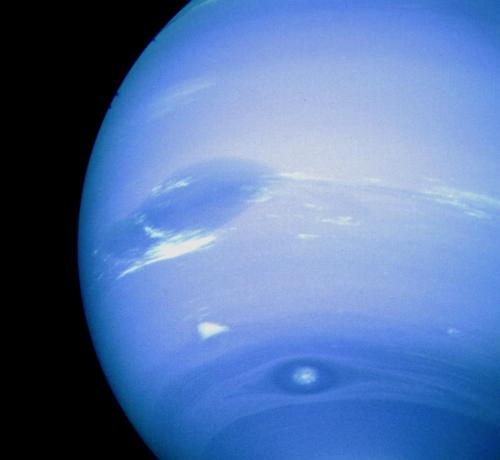
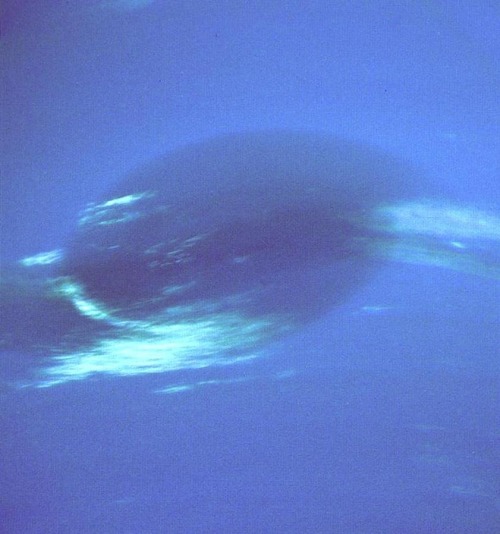
This photograph of Neptune was reconstructed from two images taken by Voyager 2’s narrow-angle camera, through the green and clear filters. At the north (top) is the Great Dark Spot, accompanied by bright, white clouds that undergo rapid changes in appearance.
Credit: NASA








Robert McCall
NASA






Other “ solar systems ”. The Milky Way has an average of 200 to 400 billion stars, not all stars have a planet around them, but others could have could have at least one planet around them or even more, could have two, four, eight , or more… now imagine the diversity of these worlds, all this is only in the Milky Way… Do you believe there is life out there?
Image credit: NASA/JPL; Tiago Campante / Peter Devine.
-
 patat-gurl liked this · 5 years ago
patat-gurl liked this · 5 years ago -
 90selderichhorror liked this · 6 years ago
90selderichhorror liked this · 6 years ago -
 7minutesafter liked this · 7 years ago
7minutesafter liked this · 7 years ago -
 predictivemarketing-blog liked this · 8 years ago
predictivemarketing-blog liked this · 8 years ago -
 megamico-blog liked this · 8 years ago
megamico-blog liked this · 8 years ago -
 cronicas-del-cosmos reblogged this · 8 years ago
cronicas-del-cosmos reblogged this · 8 years ago -
 thingsmydadmightlike-blog reblogged this · 8 years ago
thingsmydadmightlike-blog reblogged this · 8 years ago -
 adventures-thru-5th-blog reblogged this · 8 years ago
adventures-thru-5th-blog reblogged this · 8 years ago -
 yozoshimada liked this · 8 years ago
yozoshimada liked this · 8 years ago -
 fleurdebach5-blog liked this · 8 years ago
fleurdebach5-blog liked this · 8 years ago -
 gamingonethings liked this · 8 years ago
gamingonethings liked this · 8 years ago -
 ltjsol-blog liked this · 8 years ago
ltjsol-blog liked this · 8 years ago -
 beepeeps liked this · 8 years ago
beepeeps liked this · 8 years ago -
 miomckittykatofthegreatdinosaur liked this · 8 years ago
miomckittykatofthegreatdinosaur liked this · 8 years ago -
 ke-liyah15-blog liked this · 8 years ago
ke-liyah15-blog liked this · 8 years ago -
 austinmek reblogged this · 8 years ago
austinmek reblogged this · 8 years ago -
 poetcc-things liked this · 8 years ago
poetcc-things liked this · 8 years ago -
 anaadelainnerstar reblogged this · 8 years ago
anaadelainnerstar reblogged this · 8 years ago -
 anaadelainnerstar liked this · 8 years ago
anaadelainnerstar liked this · 8 years ago -
 adamadamant reblogged this · 8 years ago
adamadamant reblogged this · 8 years ago -
 bunnycakemoon liked this · 8 years ago
bunnycakemoon liked this · 8 years ago -
 completehomemaker-blog liked this · 8 years ago
completehomemaker-blog liked this · 8 years ago -
 davexxxace21-blog reblogged this · 8 years ago
davexxxace21-blog reblogged this · 8 years ago -
 davexxxace21-blog liked this · 8 years ago
davexxxace21-blog liked this · 8 years ago -
 cramindias-blog liked this · 8 years ago
cramindias-blog liked this · 8 years ago -
 thecipriansas liked this · 8 years ago
thecipriansas liked this · 8 years ago -
 matt-maesa reblogged this · 8 years ago
matt-maesa reblogged this · 8 years ago -
 johnjairogj-blog liked this · 8 years ago
johnjairogj-blog liked this · 8 years ago -
 soopspoons liked this · 8 years ago
soopspoons liked this · 8 years ago -
 kensington16 liked this · 8 years ago
kensington16 liked this · 8 years ago -
 estelsolitari liked this · 8 years ago
estelsolitari liked this · 8 years ago -
 terrie-5263-blog reblogged this · 8 years ago
terrie-5263-blog reblogged this · 8 years ago -
 terrie-5263-blog liked this · 8 years ago
terrie-5263-blog liked this · 8 years ago -
 poundthatout liked this · 8 years ago
poundthatout liked this · 8 years ago -
 mizzsweet1 reblogged this · 8 years ago
mizzsweet1 reblogged this · 8 years ago -
 rutholiveeira-blog liked this · 8 years ago
rutholiveeira-blog liked this · 8 years ago -
 sayruq reblogged this · 8 years ago
sayruq reblogged this · 8 years ago -
 sayruq liked this · 8 years ago
sayruq liked this · 8 years ago -
 petrus47 liked this · 8 years ago
petrus47 liked this · 8 years ago -
 pinksinnamon liked this · 8 years ago
pinksinnamon liked this · 8 years ago -
 thoughtfullyslocreations liked this · 8 years ago
thoughtfullyslocreations liked this · 8 years ago

